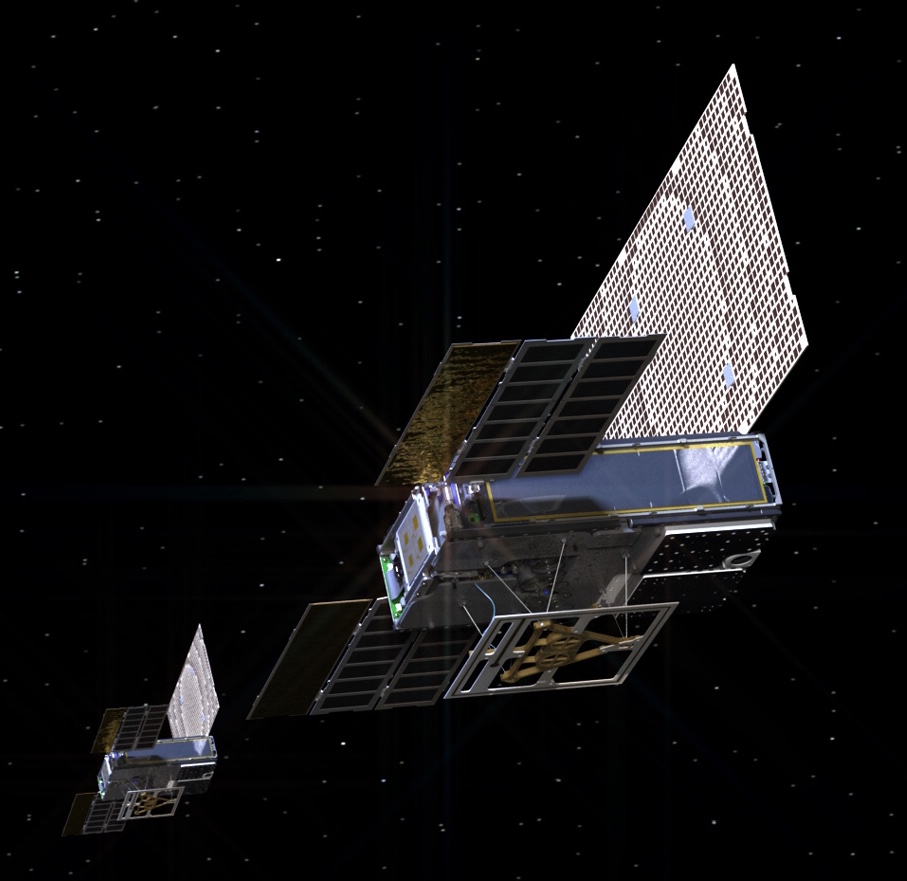Story Overview
The work of former student Ron Javor and Professor Emeritus Dr. Kai Chang was foundational to NASA's current use of microstrip reflectarray antennas. This article explains the benefits of microstrip reflectarray antennas over traditional dish antennas.
When thinking about satellite communication, most people likely picture the large parabolic dishes, or dish antennas. While these have been used for many years, dish antennas are hard to deploy in a satellite launch due to their size, and they are mechanically complex.
Enter the microstrip reflectarray antenna (MRA).
NASA’s current use of MRAs is largely influenced by the work of former student Ron Javor and Professor Emeritus Dr. Kai Chang from the Department of Electrical and Computer Engineering at Texas A&M University. Although prior to their work there were several published theoretical studies of MRAs, there was little cited work illustrating the actual design or performance of such antennas.

What sets MRAs apart
Dish antennas are very large and act like a flashlight used to aim radiated energy in a specific direction. An antenna feedhorn is placed at the focal point of the dish, acting like the bulb of a flashlight that delivers radio waves between the transmitter, receiver and the parabolic reflector.
Comparatively, MRAs are flat, which means they can conform to the surface of a satellite. They can also be scaled to large sizes and eliminate the focal point precision needed for a traditional feedhorn. In addition, MRAs have the ability to ‘electronically beam steer’— or change the direction of – the radiated energy across a field of view without any mechanical movement.
The origin story
As a young boy, Javor was captivated by the antenna technology used in walkie-talkies on television shows. That fascination stayed with him and, as a graduate student at Texas A&M, he asked Chang if he had any projects involving antennas.
“As it turned out, professor Chang did have such a project that required development and investigation – the microstrip reflectarray antenna,” Javor said. “This was actually on NASA’s ‘bucket list’ and Dr. Chang had a close relationship with Dr. John Huang, NASA’s chief antenna scientist (at the time). I proceeded to work with Dr. Chang and one of his post-doctoral students, Xiaodong Wu, to develop the test procedure and implementation. Dr. Wu’s hands-on guidance during this portion was invaluable.”
 Javor graduated with his master’s degree in electrical engineering in 1994. At that time, the process for an MRA to continuously and smoothly direct a beam across the field of view was challenging due to the lack of resources and technology. In his thesis, Javor developed a comprehensive, experimentally verified design procedure for the microstrip reflectarray antenna, which had never been done before. He included a solution for this, but it required complex electronics not available at the time. In recent years, however, there have been electronics commercially developed to make this idea a reality.
Javor graduated with his master’s degree in electrical engineering in 1994. At that time, the process for an MRA to continuously and smoothly direct a beam across the field of view was challenging due to the lack of resources and technology. In his thesis, Javor developed a comprehensive, experimentally verified design procedure for the microstrip reflectarray antenna, which had never been done before. He included a solution for this, but it required complex electronics not available at the time. In recent years, however, there have been electronics commercially developed to make this idea a reality.
“A condensed version of my thesis was published in the Institute of Electrical and Electronics Engineers (IEEE) Transactions on Antennas & Propagation in 1995 and became a key springboard for reflectarray technology development,” Javor said.
NASA’s role
In the late 2000s, Huang disclosed in a publication that NASA’s key focus for future micro spacecraft antennas were on printed microstrip reflectarray antennas.
NASA started looking into reflectarray antennas to enable the use of micro spacecrafts, called CubeSats, which are extremely small, cost-effective satellites intended for science investigations, new technology demonstrations and advanced mission concepts. Because MRAs are so small, they can be easily folded into the satellite during launch. Upon deployment, the panels unpack and unfold from the launch rocket. This would be impossible with a traditional parabolic dish antenna.
Due to its many capabilities, the door has just opened for the development, research and application of printed reflectarray antennas.
In recent years, NASA launched two missions designed to prove the benefit of using reflectarray antennas for the first time in outer space on CubeSats. In fact, in 2018, NASA launched their MarCO CubeSats into deep space where they accompanied the Insight Mars Probe and successfully acted as a data relay between the on-ground probe and Earth, more than 33 million miles away.
“Since 2010, there has been an accelerating resurgence in space exploration, research and development,” Javor said. “NASA has since developed and deployed a novel and compact integrated solar array reflectarray antenna (ISARA) satellite whereby the microstrip reflectarray antenna is on the backside of the solar panels yielding a very efficient design.”
Javor explained that technology developed for the military and space sectors is often the basis of significant technology for the commercial sector as well. In this case, MRAs have the potential to contribute to fifth generation wireless (5G) infrastructure, which is the future of cellular technology.
“5G cellular technology operates in millimeter wave frequency bands (28GHz and higher), which favor MRAs for the best power, gain and bandwidth, and as such, reflectarray development for 5G Cellular infrastructure is actively underway” Javor said.